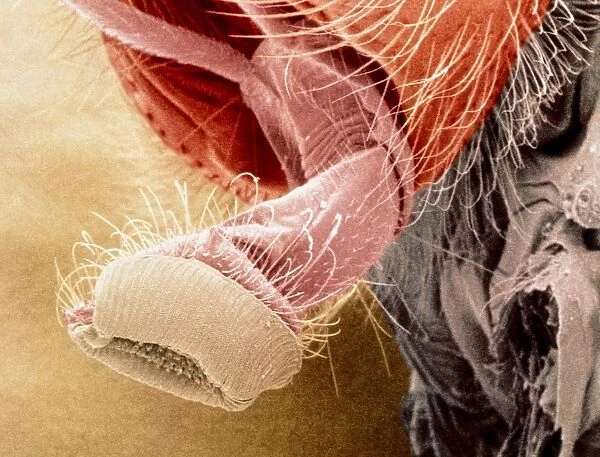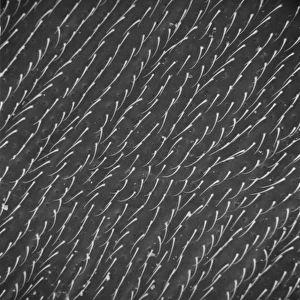Home > Science > SEM
Coloured SEM of proboscis of flesh fly, Sarcophaga
![]()

Wall Art and Photo Gifts from Science Photo Library
Coloured SEM of proboscis of flesh fly, Sarcophaga
Proboscis of flesh fly. Coloured scanning electron micrograph of the proboscis of a grey flesh fly, Sarcophaga carnaria. The proboscis is an elongated feeding organ used to sponge up liquid or soluble food, (dead or decaying flesh in the case of the flesh fly). The sponging surface seen here consists of two labella (grey), covered with a network of branching grooves (pseudotracheae). It is this sponge organ which conveys liquid food to the mouth. Solid foods are dissolved in a drop of saliva & sucked up in the same way. The hairs fringing the proboscis are sensory receptors that enable the fly to taste" substances and test for palatability. Magnification: x30 at 5x7cm size. x95 at 10x8"
Science Photo Library features Science and Medical images including photos and illustrations
Media ID 9331729
© POWER AND SYRED/SCIENCE PHOTO LIBRARY
Insecta Proboscis Flesh Fly Fleshfly
EDITORS COMMENTS
This print showcases the intricate beauty of a flesh fly's proboscis. The coloured scanning electron micrograph reveals the elongated feeding organ of Sarcophaga carnaria, commonly known as a grey flesh fly. This remarkable proboscis serves as a versatile tool for sponging up liquid or soluble food, particularly dead or decaying flesh. The image highlights two labella, which are grey in color and form the sponging surface. These labella are adorned with a network of branching grooves called pseudotracheae. It is through this sponge-like structure that liquid food is conveyed to the mouth of the fly. Even solid foods can be dissolved in saliva and sucked up using this incredible adaptation. Delicate sensory receptors in the form of tiny hairs fringe the proboscis, enabling these flies to taste substances and test their palatability. Each hair acts as an essential sensory receptor for these insects. With magnification at x30 for 5x7cm size prints and x95 for 10x8", this photograph allows us to appreciate nature's microscopic wonders on a larger scale. It provides valuable insights into insect anatomy while showcasing the fascinating world of invertebrates. This stunning image from Science Photo Library captures both artistry and scientific precision, offering viewers an opportunity to marvel at nature's intricate creations within our own ecosystem.
MADE IN AUSTRALIA
Safe Shipping with 30 Day Money Back Guarantee
FREE PERSONALISATION*
We are proud to offer a range of customisation features including Personalised Captions, Color Filters and Picture Zoom Tools
SECURE PAYMENTS
We happily accept a wide range of payment options so you can pay for the things you need in the way that is most convenient for you
* Options may vary by product and licensing agreement. Zoomed Pictures can be adjusted in the Cart.



